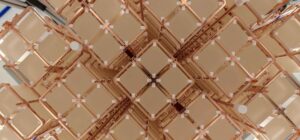PageContent
CUORE
(Cryogenic Underground Observatory for Rare Events)

A search for neutrinoless double beta decay
CUORE (Cryogenic Undregroung Observatory for Rare Events) is designed to detect the signature of a theoretical double-beta decay process in which no neutrinos are created (0νββ).
Neutrinoless double beta decay violates the rules of the Standard Model of Particle Physics. Specifically, if the electrons are emitted without neutrinos, this violates lepton number conservation. Any process that violates lepton number conservation (such as 0νββ decay) opens the door to theoretical physics models seeking to explain why there is more matter than antimatter in the universe.
CUORE, at the INFN Gran Sasso labs, is the largest bolometric experiment ever built. The detector consists of 988 Tellurium dioxide (TeO2) crystals for a total mass of 742 kg. The crystals act both as source and as detector of the signal (blometer): every time a tellurium nucleus decays or a particle interacts in the crystal, it releases a minute amount of energy causing the temperature of the crystal to rise slightly. For this temperature rise to be measurable, the baseline temperature of the crystals must be very low. We use ultra-cold cryogenic temperatures: a few thousandths of a degree above absolute zero. The CUORE cryostat forms the coldest cubic meter in the universe !
The experiment is presently taking data.
Activities in Bologna
The Bologna group of CUORE is responsible for:
- the hoist system of the cryogenics shields
- building and maintainance of the “Permanent Storage Area”
- database of the Permanent Storage Area
- slow-monitor
- seismometric system
The CUORE group in Bologna
- Giacomo Bari, INFN researcher
- Antonio Chiarini, INFN technician
- Francesca Delcorso, INFN technician
- Niccolò Moggi, PostDoc University of Bologna
- Stefano Zucchelli, Prof. University of Bologna
Official site and other links
CUORE site at LNGS (not updated)
Pictures and videos












